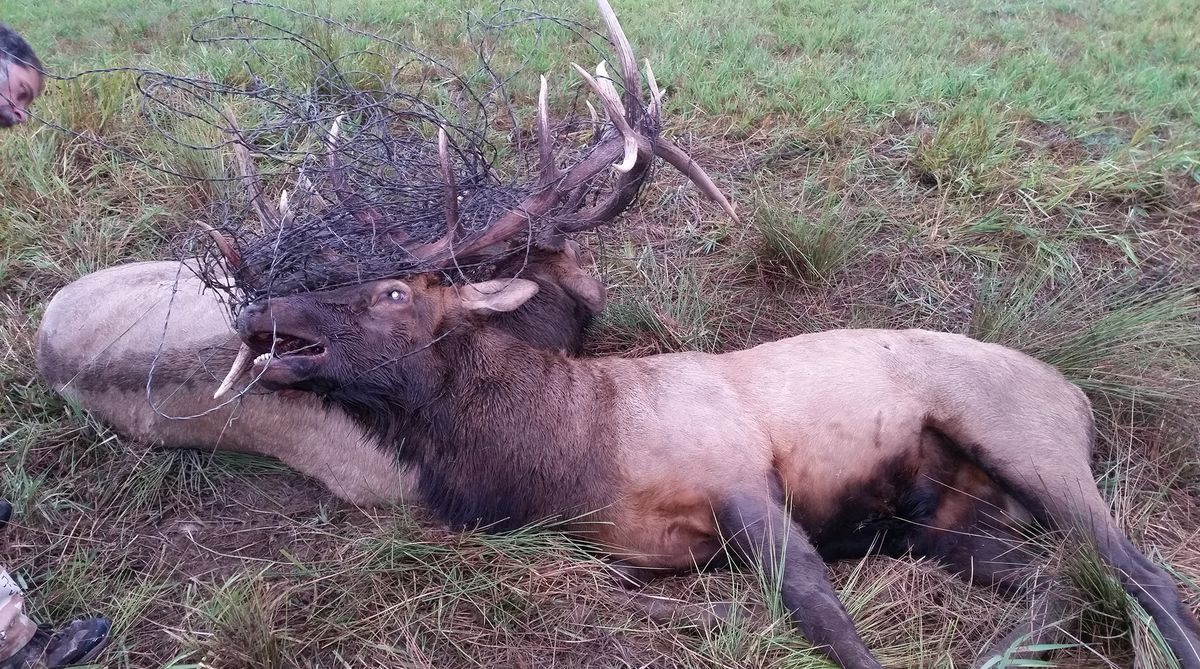Bull elk that battled to death feeding the hungry in Idaho

The powerful story of two bull elk fighting to their death for breeding dominance east of Coeur d’Alene has a mostly positive ending, although not for the herd’s gene pool.
Rancher Joe Lenz points out chunks of sod torn by hooves from the pasture on the family’s 410 acres up Alder Creek near Wolf Lodge. The churned up dirt over a vast area helps describe the spectacle as the bulls locked horns in a shoving match that went bad before dawn on Friday.
Elk in herds of up to 80 occasionally feed in the meadows not far up north from Interstate 90 to the enjoyment of wildlife watchers passing by on the local road. But this brutal match apparently was initiated in the privacy of darkness.
Battles such as this are going on this month during the rut all over elk country. In most cases, one bull proves his superiority in the pushing and the challenge ends with the loser trotting off to soothe a bruised ego and rethink his desire to become a herd bull.
Young bulls take their licks before a few of them get tough enough to dominate a harem of cows and calves. Others are life-long satellite bulls that cruise the edges of a herd bull’s range, looking for an opportunity to catch a receptive cow straying from the harem.
Every dominant bull eventually meets his match.
But in the case of the Alder Creek bulls, there was no winner. Their massive antlers tangled in the barbed-wire fence as they fought, dooming them both.
Lenz found them the next morning on their sides hopelessly bound together. One bull had just expired, its neck apparently broken, but the other was hanging on to life. Both had been gored multiple times.
“I’ve lived here all my life and never seen anything remotely like that,” said Lenz. “All four strands (of wire) were damaged in that tenth-of-a-mile stretch, so they took out about a quarter mile of fence total. I’d say there was about 50 pounds of wire tangled in their antlers alone.”
Lenz called Idaho Fish and Game Department officials. He also dispatched the suffering survivor of the battle.
The next step, as any big-game hunter knows, is when the work began.
The elk that had died in the battle was a 7- to 8-year-old, 6-by-6 point bull, said Wayne Wakkinen, Idaho Fish and Game’s regional wildlife manager.
The larger of the two elk, which had to be euthanized, was a 6-by-8 point bull around 4 years old, he said.
Having an event like this occur on a rancher’s land has a huge advantage, Wakkinen said: “They have tractors.”
Lenz and his neighbor brought two tractors to the scene. After the prickly chore of cutting the barbed wire off the elk heads, they used a fork lift to raise the massive bulls for gutting, skinning and butchering.
Fish and Game staffers were able to salvage 1,017 pounds of meat from the two bulls and deliver “one heck of a pickup-load of protein” to the area food bank, Wakkinen said.
The antlers also were salvaged and will be available to the public during the Fur Auction the agency holds each spring somewhere in the state to sell wildlife skins and parts staffers collect in the course of their enforcement and conservation work.
“They were big animals, probably 1,200 pounds or more on the hoof apiece,” Lenz said. “They were bigger than most any hunter would take in a lifetime.”
Dawna Lenz, Joe’s wife, said some people have wondered if the landowners got to keep the meat.
“We’re so happy that so much meat is going to the needy,” she said. “I tell people, ‘No, we didn’t get the meat, but Joe got to keep the mess!’”